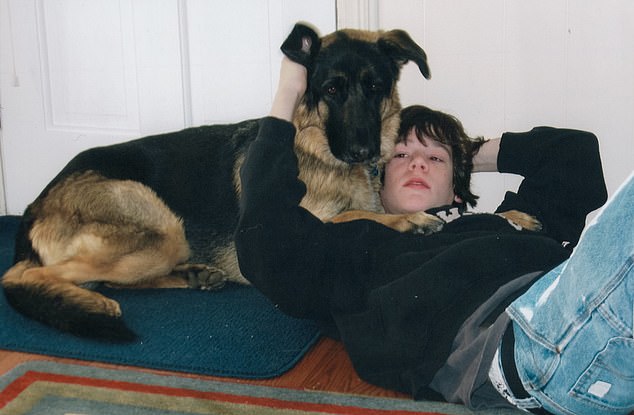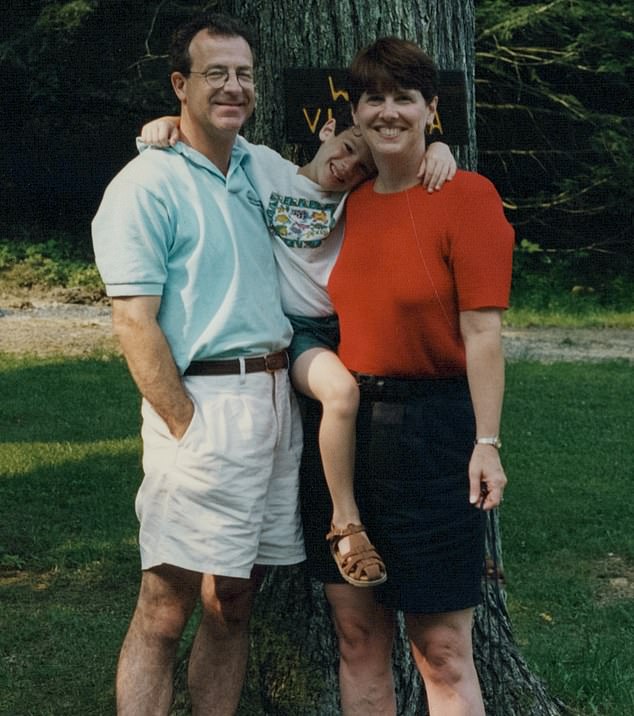My son died of a heroin overdose. Here’s what I wish I knew and how you can save your own child
If it can happen to my family, it can happen to yours.
That’s what a New Jersey mother told DailyMail.com she wants other parents to know after her 25-year-old son died of a heroin overdose on Mother’s Day.
Patricia Roos’ son, Alex, was found dead on the street in Newark, New Jersey, 20 miles from their home, succumbing to his three-year battle with drug addiction, which has left him with twelve stints in rehab and four stays in sober living homes . .
Like thousands of other victims of the opioid epidemic, Alex came from a good family. He was born to two sociologists who settled into a pleasant middle-class life in New Jersey. He was athletic and smart, and he had a college degree in biology.
Mrs Roos spoke to DailyMail.com about the signs she wished she could have looked for that could have saved her only child in the hope of saving other families from a similarly devastating experience.
Alex Roos died in 2015 at the age of 25 from a heroin overdose. His drug use skyrocketed the summer after he graduated
Alex was a varsity athlete in baseball. He was sensitive, loved music – especially electronic dance music – and was particularly close to his grandmother, whose death, Mrs. Roos, certainly had a major influence on his drug use during his first summer home after college.
He had plans to go back to school at Rutgers University to earn a master’s degree in business administration, but those crumbled as his drug use continued.
Just a few days after returning to New Jersey in May 2015, after years of bouncing from rehab to rehab in Florida, Alex was about to enter his 13th recovery center. Instead, he was found dead in a vacant lot frequented by heroin users.
During his multi-year battle with heroin addiction, his longest period of sobriety was approximately five months. But each time he relapsed “it became more and more horrific,” Ms Roos said.
‘On his 25th birthday we had to unlock the door and go in and I thought he was brain dead because he was breathing very heavily and gray stuff was oozing out of his mouth.’ She told this website, adding: ‘He was brought back several times (with) Narcan and the last time was what would have been his 13th rehab and he was refused entry.’
Knowing that her situation is not unique, Ms. Roos turned her grief into advocacy and writing, eventually publishing a book about her experiences and shortcomings in the recovery care infrastructure, called Surviving Alex: One Mother’s Story of Love, Loss, and Addiction.
She told DailyMail.com: ‘Every day when I sat down to write, I thought I was writing for people like me who are going through this, because I want them to know I hear them. They are not alone.
“I want people to know that if it happens to my family, it can happen to any family, right? Because I don’t think people think it can happen to them. And that is possible.’
In her book and during a talk on this website, she revealed signs that other parents can look out for before it’s too late to help their own child.
Struggling with anxiety or other mental health conditions
Alex was about twelve years old when he was first hospitalized, but it wasn’t for substance use or depression. He spent more than two months in hospital being treated for anorexia.
Ms Roos said: ‘And then we started to realize his anxiety level. Before then we were a normal family. We did all those things that normal families do.
“Lots of neighbors hanging out in the backyard, the kids doing plays, typical summers hanging out with your friends and having barbecues and so on.
“In seventh grade he was talking about how he had had two classes on the obesity epidemic and he had read about anorexia… He asked his father how do I get a six pack and his father said you should exercise and not burgers more. So he really took that to the extreme.”
Anorexia and anxiety often go hand in hand. The eating process becomes an obsession and the fear of gaining weight takes over. The disorder manifests in micromanaging all the food a person ingests as a means to exert control over one’s own life and to combat the fear of losing control, also known as anxiety.

Alex became increasingly isolated in his years of active addiction, often sneaking around and going missing for days
About one in three people with an eating disorder is male. About 20 percent of people with anorexia and 30 percent of people with bulimia are men.
Likewise, substance abuse and anxiety often co-occur. A large-scale study that reflected data from more than 43,000 Americans found that generalized anxiety disorder was the anxiety disorder most often associated with the use of alcohol or drugs to self-medicate.
Ms Roos said: ‘You think about the psychological kind of factors that are systemic – depression or anxiety – but there are also socio-economic, systemic factors, poverty, unemployment, incarceration, racism. These are all the contexts in which people live.
‘What is the message I want to give to parents who are concerned about this? The first thing you need to do is assess the risk. So, what are the psychological factors?
‘Do you have psychological problems in your family, in your extended family? Do you have alcoholism in your family or extended family? And that allows you to better assess the risks you face.
‘It’s important to understand that young people mainly use drugs for self-medication, right? And in Alex’s case, that’s exactly what was going on, and we saw that when he was anorexic.”
The recent National Epidemiologic Survey on Alcohol and Related Conditions found that nearly 18 percent of people with a substance use disorder also met criteria for an anxiety disorder.
A separate study by Yale researchers The anxiety disorders found often precede the onset of an alcohol abuse disorder and can coexist. In 57 to 80 percent of cases where people had both an anxiety disorder and an alcohol disorder, the anxiety appeared first.
And in at least 67 percent of cases where people had both an anxiety disorder and a drug addiction, the anxiety disorder came first.
The rehabilitation programs Alex attended usually consisted of twelve steps that discourage the use of mind-altering substances, including anxiety medications.
Although he was not prescribed them consistently during his years of active addiction, Ms. Roos said that at one point he was able to obtain a three-month supply of Xanax and Ambien from a doctor at an urgent care clinic.
Sneaking around
Alex’s mother said her son began exhibiting “sneaky” behavior after being released from the hospital. It started with him secretly drinking while attending high school in Metuchen, New Jersey, and continued into college.
And like many drug or alcohol abusers, Alex was good at hiding it.
Ms Roos told DailyMail.com: ‘Shortly after he came out of hospital he started drinking secretly and we didn’t know how much he was drinking. But… in high school it was a little more problematic. And in college it became much more problematic.”
The summer after graduation in 2012 was marked by a series of deaths in the family, further increasing Alex’s anxiety and depression.
His mother added, “When Alex graduated in 2012… he really got into drugs. (In) 2013 was the first time he overdosed, and we had to take the door off its hinges to find him, overdosing on heroin.”
Being sneaky doesn’t have to mean not using drugs at all. A person who uses drugs compulsively may lie and say that drugs are an occasional indulgence.
It’s also not uncommon for compulsive drug users to sneak out for days at a time.
Before Alex’s fatal overdose, he had not been in contact with his family for six days, and that was not the first time.
Drug use is often a lonely activity, and that became even more so during the Covid pandemic.
People often go to toilets to inject drugs, and Ms Roos said parents should pay attention to how often and how long your child is in the bathroom.
She said: ‘It’s important to pay attention if children start to self-isolate, start to lose friends, if they spend a lot of time in the bathroom, because a lot of drug use is happening in the bathroom because that’s one of the few places where people I think they can find the privacy they need.’

Patricia Roos (pictured next to Alex and her husband, left) said Alex was a happy, athletic child with a ‘wicked sense of humor’
Selling stuff
Drugs are not free, and for an addict, obtaining them becomes more important than securing food or a place to live. For drug users without disposable income, this often means selling valuable possessions.
It may also be necessary to steal from family to turn some heirlooms into silverware for a profit.
According to Ms Roos, Alex begged at a local train station and sold ‘lots of different things’ to fuel his addiction.
Ms Roos told this website: ‘We put our rings in a safe because we didn’t want him to take them and sell them. And he was aware of all this.
‘I remember having lunch with him and he said, “Oh, you’re not wearing your rings.” And I said, “Yes, we put them in the safe.” And he said, “Because of me?” and I said ‘yes,’ and he just felt terrible.”
Part of the appeal of heroin, as well as that of fentanyl and other opioids sold on the street, is that they are not very expensive. A bag of heroin costs about $5 and prices remain low because of the cheap and plentiful fentanyl.
Fentanyl and other illicit opioids are rapidly being produced on a large scale, largely from China through Mexico, but also in smaller clandestine U.S. labs.
Efforts to prevent fentanyl from reaching the streets are taking on a fool’s errand, with drug makers creating increasingly deadly fentanyl analogues.
And there is little evidence that the flood of illegal drugs on the streets of American cities is abating.
